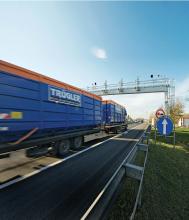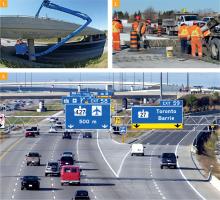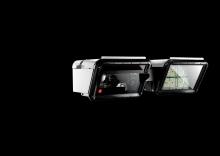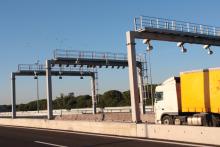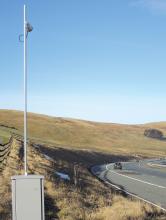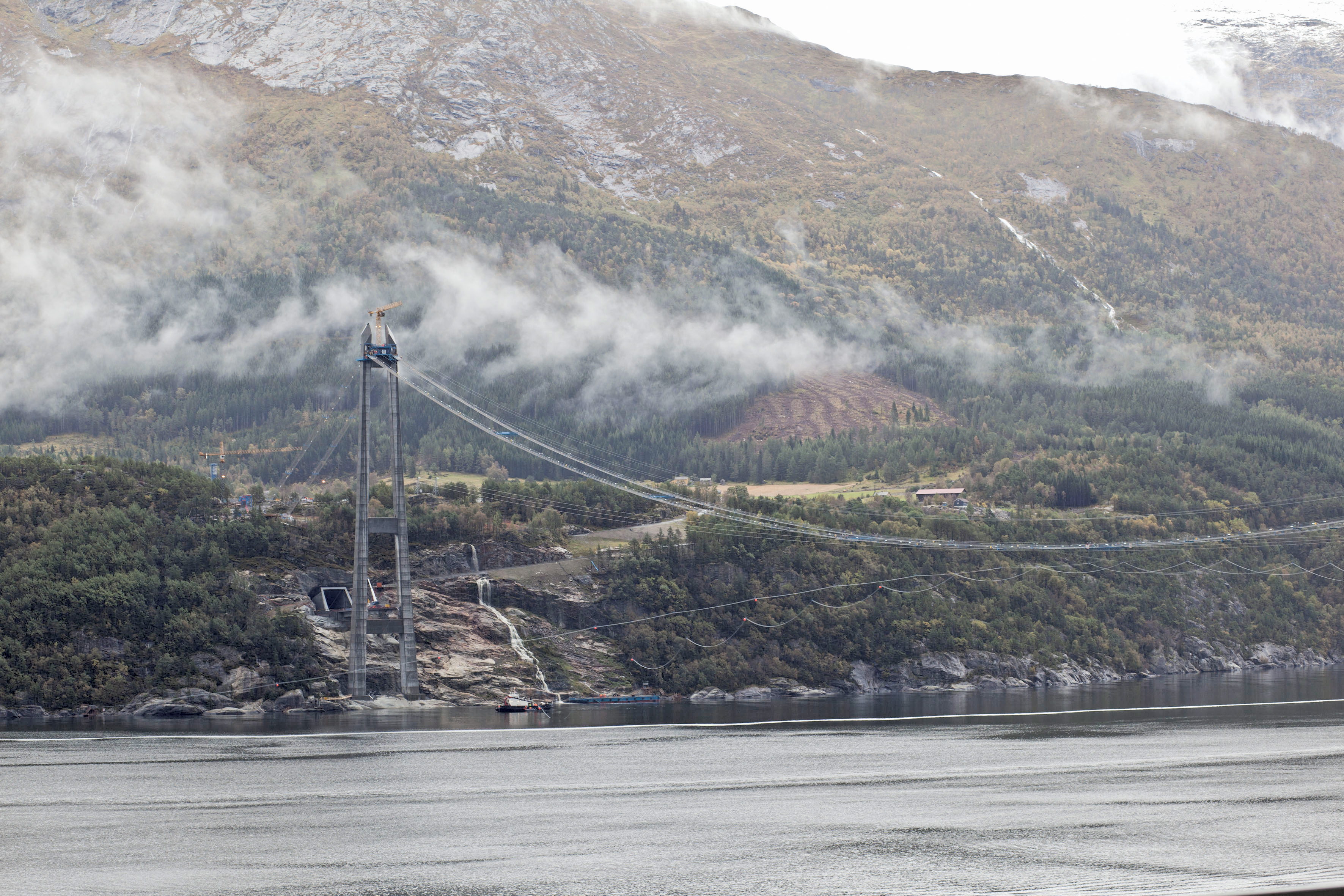
The world’s leading tolling solution providers have achieved significant deals in recent months emphasising the importance of their latest and proven technology. Guy Woodford reports
“We look forward to continuing our sixteen-year partnership with the 407 ETR and providing the next generation of transponder technology, benefitting the 407 ETR’s growing community already exceeding seven million customers,” said Chris Murray, president and CEO, Kapsch TrafficCom North America. “Kapsch has enabled many landmark ITS deployments around the globe and we are proud to have the world’s first all-electronic toll road in our customer portfolio.”
“ITS Canada is thrilled to note that a local supplier and longstanding member of ITS Canada, Kapsch TrafficCom, has once again been successful in providing transponder design and supply to another of ITS Canada’s members, 407 ETR, the world’s first all-electronic toll highway, in operation since 1997,” said Carl Kuhnke, executive director, ITS Canada. “These organisations are working hard to ease what is now the fourth most congested traffic region in all of North America.”
The 407 ETR is the world’s first all-electronic, barrier-free toll road located in the Canadian province of Ontario. Commonly referred to as Highway 407, the road runs 108kms east and west just north of Toronto: from Burlington in the west, to Pickering in the east. Since its opening in 1997, 407 ETR continues to fulfil its mission of relieving congestion on Greater Toronto Area highways.
In Europe, Kapsch TrafficCom implemented an electronic tolling system in Belarus for vehicles exceeding less than 3.5tonnes (exempt from Custom Union), starting technical operations on 1 July 2013. This has been followed by commercial electronic charging from 1 August 2013.
The new system will initially cover 815km of Belarusian motorways. It envisages further expansion of the system through the construction of road infrastructure within other highways’ sections, which are to become to toll roads in the future.
Kapsch TrafficCom received the order for the implementation and operation of a nationwide electronic toll collection system in Belarus in February 2012. The system is based on dedicated short-range communication and operations are scheduled for a period of 20 years.
The biggest single deal, with
Vinci Autoroutes is the largest highway operator in Europe with more than 4,000kms under their concession, representing half the under concession national network. The tags order will be delivered within mid-2015.
“Q-Free has been in the French market for many years, and we are pleased to strengthen our position in the important French tag market,” said Q-Free CEO Øyvind Isaksen.
Q-Free has also been awarded an order worth €3.41 million (NOK27 million) from Centro Gestao Meios de Pagto (CGMP) in Brazil.
The order will be delivered in the second half of 2013.
Q-Free has a fully owned subsidiary in São Paulo, Brazil.
Finally, Q-Free has closed a €1.51 million (NOK12 million) tags supply deal with EXAT Expressway Authority of Thailand.
“Due to increased traffic and electronic tolling gaining popularity, we foresee that both new infrastructure and tag opportunities will gradually increase in Thailand going forward,” said Isaksen.
The order will be delivered in the near future.
Q-Free claims its fourth generation OBU610 transponder is the most advanced of its kind in the world. Designed to blend into the interior of any modern vehicle and small enough not to obstruct views, the OBU610 is said to be powerful enough to support all applicable protocols in the world of 5.8GHz CEN DSRC for automatic registration, identification and fee collection from vehicles.
The OBU610 is easily mounted and removed from the windscreen using a slide-in bracket, which additionally serves as a removal-detector.
The Norwegian Haulier’s Association (NLF) claims the tolls for the about to open, newly built Hardanger bridge are far too high and will curb traffic.
Tolls have been set at €75.84 (NOK600) for vehicles over 3.5tonnes and €18.96 (NOK150) for regular private vehicles.
Additionally, Jan-Ove Halsøy, district leader of NLF, says the suspension bridge is 15 years too late as freight traffic has already shifted to new routes via Haukeli or Hemsedal.
Under construction since 2009, Hardanger bridge will have one of the world’s longest spans at 1,310m. Unusually, it will have no back spans. Instead approach roads will be through tunnels in the mountains, connected across short viaduct links – 25m on the north side and 45m on the south. This is because the terrain leaves no way to put the bridge pylons further out.
Tolls are set to cover 62% of the Bridge’s total cost of €290.74 million (NOK2.3 billion). Funds have also been provided by local and central government, and form savings from the closure of a subsidised ferry service.
According to global management consulting firm McKinsey & Company (M&C), toll road operators are sharpening their focus on operational excellence in a bid to reduce costs and counter recent setbacks to their returns, which include a decline in traffic and revenue growth, fiercer competition and poor execution in developing markets.
Samuel Magid, senior expert at M&C, claims the majority of toll road operators have opportunities to realise significant performance improvements through operational excellence. A number of operators in Europe, Latin America and beyond are said by Magid to have already achieved cost reductions of 10-20%, equating to an increase in company value of 5-10%.
“For most operators, 60-70% of their addressable cost base comprises materials and services purchased from external suppliers; spend and procurement decisions are typically fragmented, within an environment offering limited competition. Some have achieved savings of 10-20% by reviewing spend, prices and suppliers to identify cost reduction levers, offsetting imperfect market mechanisms on strategic materials, like direct import, identifying alternative suppliers to increase competition, and using alternative contracts such as incentives-based combinatorial sealed bidding,” said Magid. “These measures have been aided by centralised responsibility for strategic sourcing to secure optimal procurement expertise, including demand management, market analysis, negotiation and commercial skills.”
By leveraging scale and building capabilities to question existing specifications, Magid claims one operator secured 13-18% savings on maintenance services; another reduced winter maintenance costs by 10%.
Cost-benefit analysis is also said by Magid to provide another opportunity for road operators to understand where benefits of a project genuinely exceed costs in areas such as safety, comfort, and aesthetic value. “This typically leads operators to strip back to the core elements, and also helps to standardise and simplify operations, which can drive lower costs with no negative impact for users,” he said. “Standards for maintenance of capital assets should be based on Total Cost of Ownership (TCO) calculations which prove, for example, that sealing and draining at regular intervals saves money. The optimal level of maintenance for an existing road network can be gauged by calculating how the combined running and renewal costs of a road develop as a function of its condition.” According to Magid, optimisation of this kind has helped operators to cut life cycle maintenance costs by 10-20%.
The leading global consultancy firm claims a reduction in the material and personnel required by road operators can be generated through lean approaches to road maintenance and construction processes. Explaining this approach, Magid added, “In Latin America, multifunctional teams achieved 20-30% higher productivity than specialised teams, while light machinery for pavement maintenance helped a European operator to reduce the team size by up to 30%. In Asia, optimising the space used to transport equipment and material led to a 30% reduction in trucks required.” The spokesperson claims that personnel responsible for tasks that add value to customers (toll collection, road inspections, etc.) spend as little as 30-35% of their time performing these activities. “Using proven lean interventions, road operators have reduced operating costs by 1-3%,” added Magid.
Additionally, some operators are said by Magid to have created shared service centres to gain economies of scale and standardise common processes. “Costs are also driven down – and quality and efficiency enhanced – through shared recruiting and the realization of offshoring and/or redundancy potential. Recent implementation cases show opportunities for a 10-15% cost reduction in total support functions baseline,” he said.
STAR Systems International, a leading provider of UHF RFID tags for automatic vehicle identification, says the VENUS windshield tag is to be used in India’s United Electronic Toll Collection System across all toll plazas along the national highways.
The announcement comes just in time for Indian automobile manufacturers who must comply with the country’s Central Motor Vehicles Rules. The new rules require that vehicle builders must fit a RFID tag on the windshield of all motor vehicles starting in October 2013.
“The VENUS windshield tag offers Indian automakers a ready-to-use solution to meet the latest government regulations, “said Jet Lai, senior applications manger of STAR Systems International. “Tags can be custom printed and programmed to meet each individual automaker’s needs. STAR Systems International not only provides tags and readers, our customers also benefit from the STAR Systems team’s full expertise in implementing UHF RFID systems for electronic tolling collection and vehicle identification solutions.”
The team at STAR Systems International successfully co-developed and deployed the eTag tolling system currently being used island-wide in Taiwan. The company said that the Taiwan system is now being used on over 82% of all toll transactions with excellent results. STAR Systems International also has experience in Thailand, Turkey, India, Vietnam, and the USA with vehicle and other automatic identification systems.
The VENUS windshield tag is said to be especially suited for ETC using ISO 18000-6C passive tags. It uses patented Break-On-Removal (BOR) and tamper-evident technology to ensure physical tag security along with innovative data security algorithms. It is tuned for vehicle and tolling applications. In tolling and other vehicle applications, Star Systems International says it is critical to have a consistently reading tag within the “read zone”. Weak tags could be missed while extra-strong tags can cause issues with cross lane reads. The VENUS tag is designed and produced to provide this type of consistent and reliable performance along with having the ability to withstand the harsh environmental conditions that a vehicle endures throughout its operating life.
STAR Systems International also designs, develops and distributes high performance Readers, Hand Held Terminals, Custom Tags and Reader Antennas for all RFID applications, along with expert professional RFID services to operators, integrators and users.
Brazil to have national electronic toll payment?
The Brazilian government is considering setting up a national electronic toll payment system.
The favoured system will be based on the State of Sao Paulo's solution, which uses an electronic tagging system installed in each vehicle to charge for payments. The proposed national toll payment aims to cover the nation's roads and to track cargo in railways, airports and ports.
Brazilian planning and logistics company EPL will be responsible for setting up this tagging system, which is already used by 55% of vehicles that use tolls. When this figure reaches the 80% mark, a system to charge based on distance the distance travelled could be implemented.
Meanwhile, as part of the National Automated Vehicle Identification System (Siniav), it was suggested that the tracking systems could be installed in vehicles by car manufacturers, so that it would not incur extra costs for car owners. Nevertheless, car owners would still have to select a payment system operator, such as Sem Parar, Auto Expresso and ConectCar. The Brazilian government is also said to favour using this system to track products leaving factories and thus reduce the incidence of fraud and thefts.
RSS

